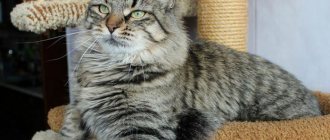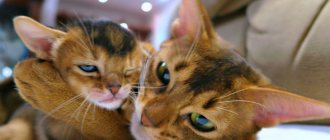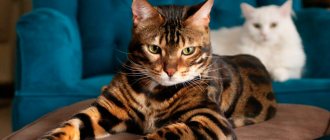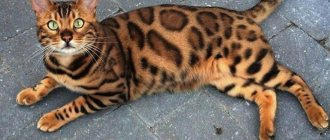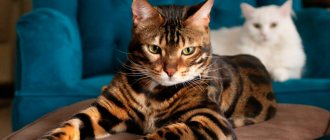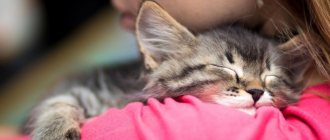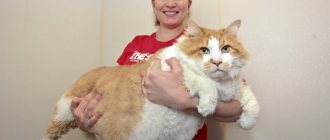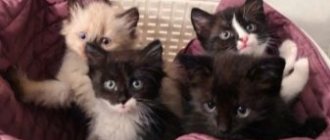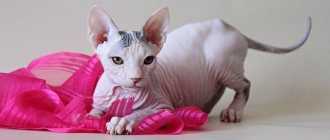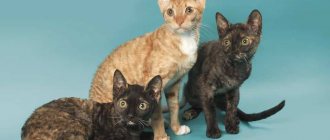Home » About cats » Do cats like to hug?
A quick search on the Internet will reveal hundreds of images and videos of cats hugging each other and their kittens, people, as well as dogs, ducks, toys, tree branches and inanimate objects!
But do cats really love cuddles and enjoy cuddling with their owners?
Do cats like to cuddle?
Cats do not have complex social relationships. This is due to the fact that their ancestors, African wild cats, were solitary predators.
This will make our social interactions seem strange to cats, since most people use touch all the time, whether it's a handshake, a light touch on the arm, or trying to walk together holding hands. For cats, even if they look like they're cuddling, it looks and means a little different.
Petting a cat has all sorts of benefits for human health, reducing stress and improving our mood.
Many countries even have a national cat day!
But is it as good for them as it is for us? Some cats love contact with us, others that can accept affection and hugs from a person or not, and others avoid physical contact with the owner, but this does not mean that the cat does not love him.
This is because cats love to maintain a sense of control, which includes being able to escape from any situation.
When we hug cats, we are actually containing them in our embrace and limiting their movement.
Cuddling kittens
One of the images I came across while searching for cuddling kittens shows two felines, one standing upright with his front paws wide open and looking at the other kitten across from him, who appears to be sitting nonchalantly.
You might think that a kitten standing upright really wants to hug its furry friend. In fact, a kitten standing on its hind legs is using the other as hunting practice, while a sitting kitten is preparing to defend itself.
While this obviously seems like a joke, it perfectly illustrates the very human perception of cat behavior.
Disease
If pooping on the bed is a new behavior for your cat and there have been no recent changes in the family, first look for illness. Some health problems are very time sensitive, so knowing what to look for can help.
There could be several medical reasons why your kitty is interested in your bed as a litter box. Here are some of the diseases that could be the culprits.
- Intestinal parasites
- Irritable bowel syndrome
- Food sensitivity
- Hypothyroidism
- Diabetes
- Liver disease
- Cancer
Cats hugging toys
Other images that, for example, show cats hugging a toy can also be misinterpreted.
Typically what they do is grab a toy with their front paws and scoop it up with their back legs in a "bunny" style, something that cats instinctively do either when playing or when they are involved in a fight with another cat.
They do this to cause as much damage as possible to their opponent, which you will know if the cat mistakes your hand for their opponent!
Why does a cat bite? Read here!!!
Cats hugging each other
Cats look like they are hugging when they curl up together. Yes, cats can find themselves in very strange positions to get as close to each other as possible. But in reality, cats huddle together to stay warm and stay warm, even if it's hot in your home.
So, what may look like a cat hug is a random position they've fallen into to keep warm.
It's clear that we humans are very social, we can enjoy physical contact (especially hugging furry, cute animals).
We love our cats and want them to love us and show it in ways we are used to seeing, but we may unintentionally attribute human behavior to them. Of course cats are clearly capable of showing a lot of physical affection, it's just that our interpretation of a hug may be different from theirs, and that's something to keep in mind!
Varieties of colors
How many cats - so many fur coats. Breeders are constantly experimenting with colors. They cross two parents with the desired traits and strive to imprint some exotic shade in the offspring. In this case, an arbitrary uncontrolled mutation occurs along the way, which can radically change the appearance of the animal.
It has been noticed that many breeds of tabby cats have a stable nervous system and good health. No one has yet proven a direct relationship with the type of color, but scientists are also in no hurry to deny it.
The tabby allele is located on the cat chromosome 1X, which is responsible for the immune system. A random change in the established order can destroy the natural balance.
The cat with dark stripes is found in many breeds. This pattern is also called tiger because of its external resemblance to a wild predator. The only difference is the base coat color, but the gray tabby's pattern looks identical.
Distinctive features:
- the neck is girded with narrow lines;
- thin stripes of varying lengths are located throughout the body;
- the tail is ringed along the entire length or most of it.
The name of the color must indicate the color of the ornament, and not the characteristics of the coat:
- Black tabby cat with dark lines on its skin.
- Red brindle with a pattern in shades of red.
- The blue brindle is painted with blue-gray strokes.
- The brown tabby cat has a chocolate-colored labyrinth on his skin.
Gray tabby cat species are found primarily in native breeds. Their appearance corresponds to the conditions of natural selection, living in a certain area in a natural climatic environment.
But it is almost impossible to find a pet with stripes of exotic colors (fawn, cinnamon, lilac) among gray purebred cats.
Why does a cat hug a kitten?
When human mothers give birth, a hormone called oxytocin is released, which gives them a feeling of intense connection with their baby.
This same hormone is released when cats give birth, and it also helps them fall in love with their kittens.
It's wonderful to watch a mother cat care for her kittens, feed them, protect them, provide them with the warmth they need, and teach them how to hunt!
But is this a hug in our human understanding?
Not really. Although the mother cat does not know that she is hugging the kitten, she is showing an element of maternal protection and affection towards her kitten, she is warming it up in what looks like a hug.
Cat hugs dog
Throughout history, cats and dogs have been portrayed as not the best of buddies, we even coined the phrase "like cats and dogs"!
Yes, cats and dogs are two species on opposite ends of the social and behavioral spectrum - cats like to evaluate new situations from a distance, while dogs try to immediately take part in any event.
Let's say a dog approaches a cat, the cat will perceive it as a threat and will likely run away, eliciting a playful response from the dog. It is clear that neither the cat nor the dog understands the intentions of the other.
So, for a cat to be close enough to a dog to hug him, she shouldn't be afraid of him. A typical case is when a cat grew up with a dog as a kitten and puppy and does not perceive him as a threat.
She will even use the dog as a comfortable, warm bed, but this is the exception rather than the rule, and making friends between a cat and a dog is not so easy.
Two animals in the house: behavior options
Cats are one of the most skittish pets. When two animals appear in one apartment at once, a conflict between them is almost inevitable. It's easier for an adult cat to accept if she has to adopt a kitten. It is very difficult to make friends between two sexually mature males.
Representatives of the cat world are jealous of their territory, the owner’s attention, and food. Having got a second cat, the owner must make every effort so that the first one does not feel deprived. At the same time, the new animal must be provided with the necessary comfort.
Several types of relationships can be established between two adult cats:
Friendship. At the first meeting, the animals will quickly find a common language. They will sniff each other without showing hostility. In the future, the animals can sleep peacefully together, play, and calmly be in the same room. They do not mind sharing trays and food bowls and can lick each other. Fright. Often the pet experiences real horror from the new environment. He hides under a sofa or closet and refuses to eat for several days. A frightened cat may hiss and even fight. Competition. Each animal can feel disadvantaged and offended
Pets will try with all their might to fight for a bowl of food, the best warm place, and the owner’s attention. A few days after they met, you can watch how each of the cats approaches a person, arches their back, rubs against their legs, and purrs.
In these ways, animals try to get affection from the owner.
The behavior of two animals largely depends on the character of each. Often, behavioral characteristics can be adjusted depending on the situation. For example, an adult cat calmly accepted a kitten, but when it matured, it began to experience pronounced aggression towards it. However, competent actions by the owner can minimize problems in the relationship between the two animals.
How to properly raise a kitten from an early age?
Cats hugging people
Cats are not born knowing how to interact with people, they need to learn how to be pets.
So, why do cats stand on their hind legs while their front paws reach out to their owners as if wanting to hug them?
Supposedly this is an instinctive behavior, something that some cats have learned to do because they know it will lead to pleasant consequences, such as affection or a tasty gift.
Moreover, they are probably doing this in response to a signal we have given them, either consciously or unconsciously!
Some scientists have even suggested that cats deliberately spread their scent to their owners through secretions secreted from the skin glands around their cheeks and ears, and this may be the reason why some cats also wrap their paws around their owners' necks.
Maintenance, feeding and care at home
Outdoor cats are easy to care for. They need to be cared for in the same way as purebred pets:
| Hygiene procedure | Frequency of execution | Recommendations |
| Combing | 1–2 times a week | You need to comb your tailed friend with a special rubber brush-mitten. |
| the washing up | As the wool gets dirty | Bath cats with pet shampoo. |
| Cleaning the ears | 1–2 times a week | Natural secretions and dust are removed with a cotton pad moistened with warm boiled water or a special solution. |
| Eye cleaning | ||
| Teeth cleaning | As plaque forms | A special toothbrush and toothpaste are used. |
| Nail trimming | As it grows | The claws are shortened with a special claw cutter. |
To comfortably accommodate a mongrel animal, you need:
- arrange a sleeping place for him in a warm, quiet room, where there are no drafts;
- tray with or without filler;
- scratching post;
- bowls for food and water;
- walking harness;
- play complex and (or) toys.
How to hug a cat
First, it is important to understand your cat's individual requirements for physical contact.
If he reacts neutrally or tries to break free and run away, do not touch him.
If you have a cat that likes to cuddle with you, wait until she interacts with you first before you cuddle.
Always be gentle, limit the amount of time you cuddle, watch your pet's body language, any signs of anxiety, and always stop if your cat starts to struggle.
New pets or children
If you're dating a new addition to the family—human or animal—it might not go over well with your roommate. After all, you didn't ask your cat if someone else could live with you. Your cat may have difficulty adjusting to this significant change.
They may crap on your bed, especially if a new pet or person is staying in your room. It's more of a call for attention than an angry act—no matter how you feel about it. Remember to introduce people slowly and be patient during the process. In this case, he should calm down as they acclimatize.
